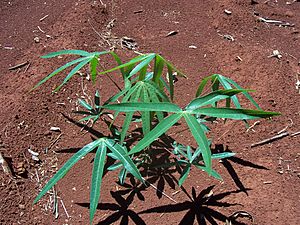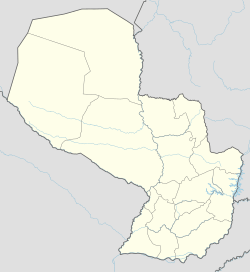Nueva Germania facts for kids
Quick facts for kids
Nueva Germania
|
|
|---|---|
| Country | |
| Department | San Pedro |
| Founded | 23 August 1887 by Bernhard Förster |
| Area | |
| • City | 657 km2 (254 sq mi) |
| Elevation | 132 m (433 ft) |
| Population
(2022)
|
|
| • Urban | 1,124 |
| • Rural | 4,566 |
| • Total | 5,690 |
| Time zone | -4 GMT |
| Postal code |
8470
|
| Area code(s) | (595) (44) |
Nueva Germania (New Germania, German: Neugermanien/Neues Deutschland) is a district of San Pedro Department in Paraguay. It was founded as a German settlement on 23 August 1887 by Bernhard Förster, a German nationalist to create a model community in the New World, demonstrating the supremacy of German culture and society.
Contents
Geography
Nueva Germania is located about 297 kilometres from Asunción, capital of the Republic of Paraguay. It borders on
- Tacuatí district to the north;
- Lima district to the south, separated from it for the Aguaray Guazú River;
- Amambay department and the Santa Rosa del Aguaray district to the east;
- San Pedro de Ycuamandyyú district and the Tacuati district to the west..
The Nueva Germania district is watered by the rivers Aguaray Guazú and Aguaray mí, and the streams Tutytí and Empalado.
Climate
The climate is tropical, with abundant rains, a maximum temperature of about 35 °C, a minimum of 10 °C and an average of 23 °C, with a humidity of 80%. Precipitation exceeds 1300 millimeters, especially in summer.
History
Nueva Germania was founded in 1886 on the banks of the Aguaray-Guazú River, about 250 kilometres from Asunción by five, later fourteen, largely impoverished families from Saxony. Led by Bernhard Förster and his wife, Elisabeth Förster-Nietzsche, sister of the German philosopher Friedrich Nietzsche the German colonists emigrated to the Paraguayan rainforest to put to practice utopian ideas about the superiority of the Aryan race. It was the declared dream of Förster to create an area of Germanic development, far from the influence of Jews, whom he reviled. It was one of several closed German communities in Paraguay.
The colony's development was hampered by the harshness of the environment, a lack of proper supplies and an overconfidence of the colonist's own supposed Aryan supremacy. Most settlers soon died of starvation and disease. Those who survived malaria and the sand-flea infections rushed to flee Nueva Germania. Those who stayed, convinced of their founder's teachings, married among themselves so as to preserve the racial stock.
Förster, who had negotiated the town's titles of property with General Bernardino Caballero, died only 3 years later in 1889 in the city of San Bernardino after abandoning the settlers. Elisabeth Förster-Nietzsche returned to Germany 4 years after his death in 1893.
20th century
According to Gerard L. Posner, writing in Mengele: The Complete Story, Josef Mengele, a major German war criminal, spent some time in Nueva Germania while he was a fugitive after World War II. However, the evidence that Mengele ever passed through is shaky at best.
21st century
Nueva Germania became a quiet community in San Pedro, dedicated to agriculture and specializing in the cultivation of yerba mate. Beginning in 2004, American conductor David Woodard embarked on a series of expeditions to the settlement. As of 2013, pockets of German culture remained, and most of the population in the area still spoke a mixture of German and Guaraní.
Economy

One of the most important products of the district is yerba mate, along with sugarcane, cotton, manioc (cassava), tobacco, sunflower, soy, wheat, banana, sweet and sour orange, Paraguayan lemon verbena and sesame.
Transportation
Route 11, a paved road, is the main access to the town, which connects it with other localities of the department via Route 8, and to Asunción via Route 3. Route 11 also provides a direct access to the Amambay departament, while a nearby junction with Route 22 allows for travel north to Concepción.
Route 11 connects it the city of San Pedro de Ycuamandyyú, the capital of the department.
Language
About 80% of the population speak the Guaraní language. The rest speak a combination of German and Spanish.
Population
The General Directorate of Statistics, Polls and Census has reported the following:
- In 1992 the district had 17,148 inhabitants, the majority of whom lived in the town of Santa Rosa del Aguaray. In 2002 Santa Rosa del Aguaray became a municipality in its own right. Consequently, the District of Nueva Germania lost most of its population and territory, though it retained the Mennonite colony Rio Verde to the north of Santa Rosa del Aguaray.
- The population is mostly rural and occupied in agricultural activities.
- The projected net population by gender for 2002 was 4,335 inhabitants (2,323 men and 2,012 women).
As of 2002, about 10% of Nueva Germania's inhabitants were of mainly German origin.
Demographics
Main social and demographic indicators were:
- Total fertility rate: 3.4
- Percentage of illiteracy in the district: 15.4%
- Percentage of housings that have power: 82.0%
- Percentage of housings that have running water: 39.6%
- Percentage of population that are under the age of 15: 39%
- Percentage of population that have access to modern housing: 41.2%
- Percentage of population that have access to modern sanitation: 20.9%
- Percentage of population that have access to modern educational programs: 13.5%
- Percentage of population that are employed in the primary sector of the economy: 60.1%
- Percentage of population that are employed in the secondary sector of the economy: 14.3%
- Percentage of population that are employed in the tertiary sector of the economy: 25.0%
See also
 In Spanish: Nueva Germania para niños
In Spanish: Nueva Germania para niños



